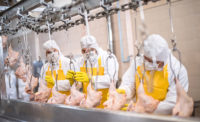I am of the hope that, sooner rather than later, we can stop proclaiming each year “crazy” or “unusual” or some other superlative. What I wouldn’t give for a normal, easy, and successful year in food safety, where challenges weren’t so mountainous and issues weren’t new. Yet, here we are, entering 2022, after another crazy, unusual, unprecedented year of challenges and issues facing the meat and poultry industries. As the headline states, the industry has quickly learned that food safety challenges come in all shapes and sizes, but with the right approach, people, and mix of technology, any processor can overcome these issues to produce safe product that keeps consumers coming back for more.
The labor challenge
Over the last year, the single biggest challenge facing the meat and poultry industry has been a severe deficit of employees — more so than in “normal,” non-pandemic times. This is not unique to our industry, which you know if you’ve been through an airport and seen temporarily closed shops, or had manufactured items shipped slowly or outright delayed. However, it is certainly having just as negative an impact on the meat and poultry industry as it is in those other examples.
The deficit is wide, particularly among skilled food safety professionals; qualified and motivated technicians, managers and directors are in short supply. Competition for their skillset and work ethic is coming from outside the meat and poultry industry. And that competition is fierce. Meanwhile, the cost of employees continues to skyrocket, putting enormous pressure on the price of products. The erosion of margin is very real, and we have not seen a lot of media discussing that issue.
According to the Web site Glassdoor.com, a food safety specialist has an average salary of $43,160*1. By comparison, a retail distribution employee makes $45,000*2. Mid-size and smaller processors are struggling to keep up with that explosion in costs.
In one small community, the local bank (yes, the bank) hired away most of an establishment’s retail crew at approximately double the salary. How and why? Well, the bank simply was impressed with the fact that they are such hard workers, so they recruited them with what must have been “an offer they couldn’t refuse,” based on their work ethic, and trained them up on the banking knowledge they needed. Fast-forward seven months and the processor is still struggling to replace those hard workers. Another facility in a different town has been unable to find the right candidate to replace their FS&Q director for more than a year, despite offering a salary package that is 20 percent higher than the posted average.
Processors are combating the deficit in a few ways, from training operations employees on how to perform food safety tasks to implementation of automation, including systems that can handle FS&Q data and inspection (think, vision systems, and automated data collection). Operations employees or a vision system can record the data, after which a trained FS&Q manager reviews the data in real-time, which cuts the number of employees needed to ensure products are safe and meet specifications.
Technology is moving fast, which has automation enthusiasts excited; but now, the supply chain is backed up. This may not be completely new, but it is something that is slowing down implementation of solutions and that planners must take into account. We encourage processors be proactive when planning purchases and to work with vendors earlier in the process to ensure equipment is actually available when needed.

The broken government: promises, promises
In June 2021, the U.S. Department of Agriculture (USDA) announced*3 more than $55 million in grants to help small and very small meat and poultry plants improve their facilities and systems to achieve federal or state inspection. Then in July, USDA further announced*5 it would issue $500 million in grants to the industry.
In November, USDA announced*4 it had approved $32 million of the $55 million offered five months prior. However, as of Jan. 1, 2022, no one I know has been able to find any company that has actually received any of the June grant money — and the $500 million July grant process still hadn’t been announced.
But that’s not all! On Jan. 3, 2022, President Joseph Biden announced*6 $1 billion to increase competition within the industry. But there have been no details on that yet either!
Those are just the grants administered by USDA. Grants awarded through the Small Business Administration (SBA) also seem to be moving in fits and starts, with some businesses receiving grant money within days and other waiting months.
These promises and then failure to follow through have left a very sour taste in the mouths of small and mid-size processors. Although members of the House and Senate are pushing to get funds into the hands of those that need them, the USDA and SBA simply are not staffed to handle this many applications and don’t have the electronic systems needed to move with efficiency. Often, too, the process itself is overly complicated and fails to have feedback mechanisms.
Technology changes
Three years ago, we saw a movement to consolidate software away from stovepipes; everyone wanted to go into the integrated Enterprise Resource Planning (ERP) type system. Then the hackers showed up and started targeting the meat and poultry industry.
In response, we are seeing companies wanting separate systems for food safety, production, and finance. In most cases, data is still entered one time but utilize multiple databases to segregate and control access. Not surprisingly, this adds cost and complexity to systems but also the multiple levels of security required in today’s world.
As companies become more reliant on the Internet of things (IoT) to record data, we are seeing a definite shift away from the one-size-fits-all mentality; data integration with definitive data flow lanes that can be locked down are becoming the normal during system upgrades.
Moving forward
From my discussions throughout the industry of late: I am hearing requests for tangible improvements to food safety. Some examples of that include remote temperature monitoring integrated to product flow; E.coli/STEC confirmed results in less than 8 hours, real-time production alerting and scheduling, etc. In each case the goal has multiple facets to include reduced employee workload, increased productivity, and minimization of human error.
The shortage of personnel is acute, and really is at a crisis level — and there’s no change on the horizon that I see anywhere. Rethinking how FS&Q operations are conducted is critical. Do you want to push data collection and action down to your operations teams, automate tasks, or implement some combination of the two? Can you get the right equipment to help reduce your reliance on employees? Can you secure your data and segregate access points to assure data integrity and security?
This year, you must take a very hard look at your operations as a whole and make structural changes to how you operate. Making these decisions now is going to be critical for future success.
1-https://www.google.com/search?q=What+is+the+salary+of+a+food+specialist
2-https://www.google.com/search?q=what+is+the+salary+for+walmart+distribution+center
6-https://edition.cnn.com/2022/01/03/politics/biden-meat-processing-industry/index.html



